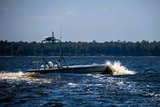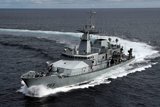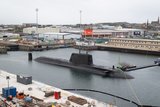Japan successfully fires electromagnetic railgun
The railgun can fire projectiles at a speed of Mach 6.5, according to ATLA. (Photo: ATLA via Twitter/X)
Japan successfully test-fired an electromagnetic railgun from a ship on 17 October, a world first and a major step in a process worth billions of Yen.
The Acquisition, Technology, and Logistics Agency (ATLA) of Japan's Ministry of Self Defence announced the success of the test on Twitter/X stating: ‘ATLA has accomplished ship-board firing test of railgun for first time in the world with the cooperation of the Japanese Marine Self-Defence Force.’
The announcement highlighted the main role of the system is to ‘protect vessels against air threats and surface threats by high-speed [munitions].’
In May 2022, the ATLA's Ground Systems Research Centre concluded a JPY6.5 billion ($47.9 million) contract with Japan Steel Works to research and prototype a railgun. Also in May, ATLA said a further contract of JPY16 billion would be inked.
Securing electrical power is a practical issue in the application of railguns. To this end, ATLA signed a JPY3.7 billion contract with Japan Steel Works to downsize power supply units and capacitors.
The ATLA railgun uses five megajoules (MJ) of charge energy and achieved a speed of about 2,230m/s or Mach 6.5 in a 2018 test. Ultimately, ATLA has said it intends it to run on 20MJ.
Other countries have walked away from railgun technology but Japan remains committed. In May, Japan announced it had developed a prototype medium railgun of 40mm calibre to research how to achieve higher initial velocity and longer barrel life.
The rail’s endurance is more than 120 rounds and can fire a projectile weighing 320gm. It has, however, been a long road with ATLA beginning research on a small 16mm-calibre railgun in 1990.
ATLA said the railgun would be mounted on a destroyer or truck to intercept hypersonic guided missiles and attack naval vessels and ground targets, despite the difficulties for a Mach 6.5 projectile with no guidance system to effectively intercept hypersonic-guided missiles flying at Mach 5-10 speeds.
More from Naval Warfare
-
![US and UK to begin Trident II D5 Increment 8 in October 2026]()
US and UK to begin Trident II D5 Increment 8 in October 2026
Trident II D5 Increment 8 will involve improvements to the shipboard navigation subsystem for the US Ohio and Columbia and the UK Dreadnought and Vanguard submarine classes.
-
![What capabilities has the US deployed in the Caribbean and South America to engage “drug boats”?]()
What capabilities has the US deployed in the Caribbean and South America to engage “drug boats”?
The US arsenal includes amphibious assault and littoral combat ships, cutters, destroyers, landing platform docks, a nuclear-powered fast attack submarine, drones, ISR aircraft, helicopters and fighters.
-
![HMS Agamemnon: details of the dive and what the Astute-class signifies for the UK Royal Navy]()
HMS Agamemnon: details of the dive and what the Astute-class signifies for the UK Royal Navy
As HMS Agamemnon moves closer towards joining the UK’s in-service submarine fleet, how does the sixth Astute-class fit into the Royal Navy’s defence strategy?
-
![French Navy frigates to align with Hellenic Navy after Aster missile enhancement]()
French Navy frigates to align with Hellenic Navy after Aster missile enhancement
The FDI frigates will have an enhanced warfare capability that matches the configuration of ships ordered by Greece.
-
![Khabarovsk submarine launch reflects Russia’s nuclear modernisation progress]()
Khabarovsk submarine launch reflects Russia’s nuclear modernisation progress
The nuclear-powered vessel, which could carry the Poseidon autonomous torpedo – dubbed the “doomsday missile” – marks another step forward in Russia’s maritime defence push.























